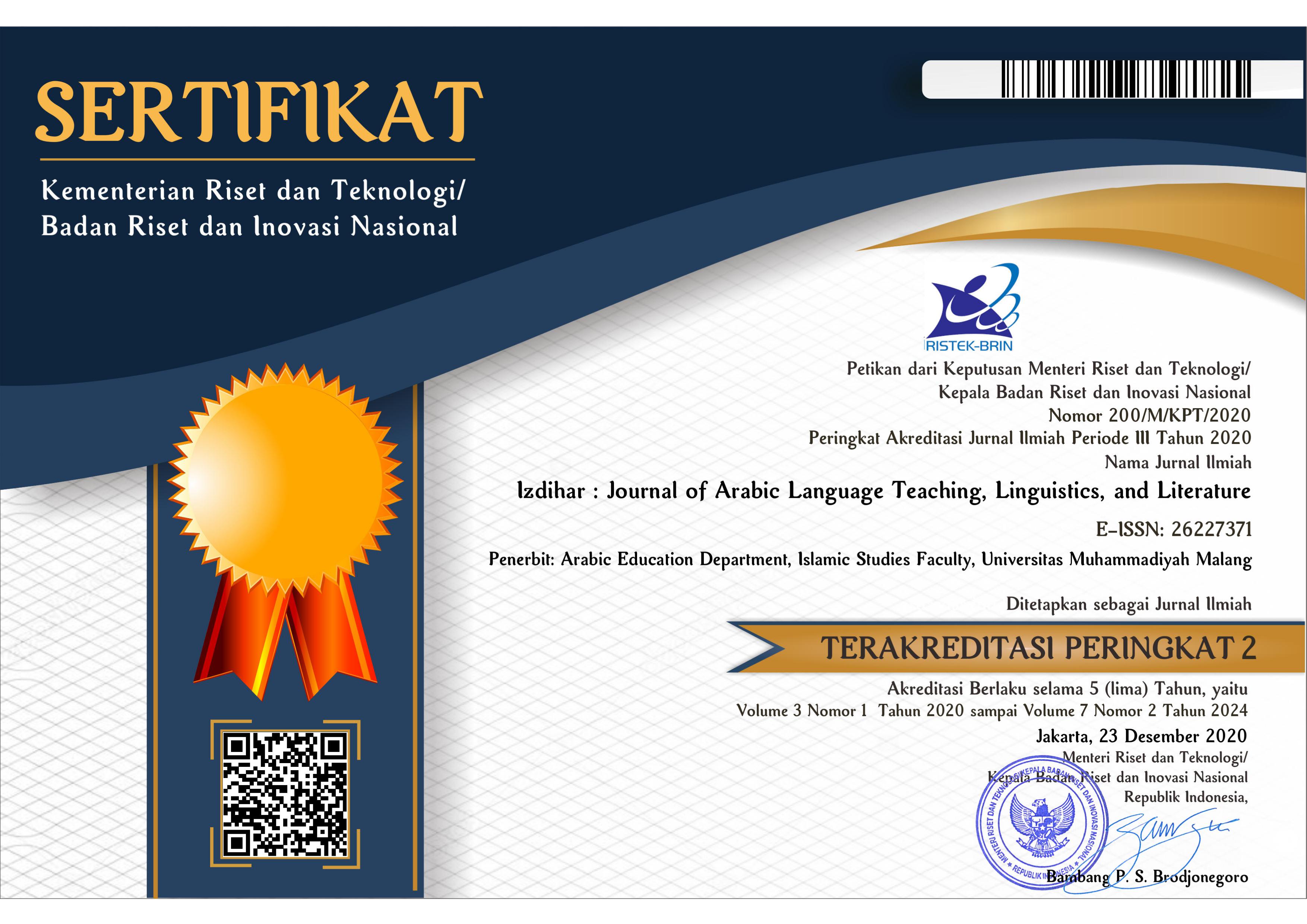The Effectiveness of Using Kahoot! Application as An Evaluation Tool in Arabic Vocabulary Learning at Madrasah Ibtidaiyah
DOI:
https://doi.org/10.22219/jiz.v4i2.17186Keywords:
Arabic Vocabulary, Effectiveness, Evaluation, Kahoot!Abstract
Kahoot application in learning can also help teachers to collect feedback from students, assess students’ learning understanding, and make surveys about problems that can be identified during learning. This research aimed to describe the effectiveness of using Kahoot! application as an evaluation tool in Arabic vocabulary learning for fifth-grade students at MI Al-Ma’arif 01 Margomulyo, Blitar. This research was qualitative with a One Group Pretest Posttest design – an experiment carried out in one group only without comparison. The samples of this research were the fifth-grade 25 students of MI Al-Ma'arif 01 Margomulyo Blitar. The results showed that the average evaluation score of the students after using Kahoot! application as a learning media increased by 75.2, much higher than before, it was 37.6. The use of Kahoot! application as an evaluation tool in Arabic vocabulary learning contributed 32% to the learning outcomes of the fifth-grade students at MI Al-Ma'arif 01 Margomulyo.
Downloads
References
Arsyad, A. (2013). Media Pembelajaran. PT Raja Grafindo Persada.
Asrori, I. (2009). Aneka Permainan penyegar pembelajaran bahasa Arab. Hilal.
Barnes, R. (2017). Kahoot! in the classroom: Student Engagement technique. Dalam Nurse Educator , 42(6), 280–280. https://doi.org/10.1097/NNE.0000000000000419
Boden, G. M., & Hart, L. (2018). Kahoot—Game based student response system. Compass: Journal of Learning and Teaching, 11(1). https://doi.org/10.21100/compass.v11i1.668
Borup, J., & Evmenova, A. (2019). The effectiveness of professional development in overcoming obstacles to effective online instruction in a college of education. Online Learning, 23(2), 1-20. https://doi.org/10.24059/olj.v23i2.1468
Bryant, S. (2018). Fun with pharmacology: Winning students over with kahoot! game-based learning. Journal of Nursing Education, 57(5), 320–320. https://doi.org/10.3928/01484834-20180420-15
Busiri, A. (2020). Pemanfaatan media kahoot dalam pembelajaran keterampilan mendengarkan bahasa Arab di IAI Sunan Kalijogo Malang. Muhadasah: Jurnal Pendidikan Bahasa Arab, 2(2), 225–240. https://doi.org/10.51339/muhad.v2i2.209
Charis, M. A. (2014). Cara mudah berbicara bahasa Arab. Lisan.
Daryanes, F., & Ririen, D. (2020). Efektivitas penggunaan aplikasi kahoot sebagai alat evaluasi pada mahasiswa. Journal of Natural Science and Integration, 3(2), 172. https://doi.org/10.24014/jnsi.v3i2.9283
Dellos, R. (2015). Kahoot! A digital game resource for learning. International Journal of Instructional Technology and Distance Learning, 12(4), 49–52.
Fauzi, M. F., Buhun, M. F., & Purwadi, A. (2019). The influence of teams games tournament (tgt) toward students’ interest in Arabic language learning. Izdihar: Journal of Arabic Language Teaching, Linguistics, and Literature, 2(2), 135–148. https://doi.org/10.22219/jiz.v2i2.9986
Guardia, J. J. (2019). Innovation in the teaching-learning process: The case of Kahoot!. On the Horizon, 27(1), 35–45. https://doi.org/10.1108/OTH-11-2018-0035
Ishak, H. B., Nor, Z. M., & Ahmad, A. (2017). Pembelajaran interaktif berasaskan aplikasi kahoot dalam pengajaran abad ke-21. In Seminar Serantau. Kedah: Jabatan Pendidikan Khas Institut Pendidikan Guru Kampus Darulaman Jitra.
Hiebert, E. H., & Kamil, M. L. (Ed.). (2005). Teaching and learning vocabulary: Bringing research to practice. L. Erlbaum Associates.
Irwan, I., Luthfi, Z. F., & Waldi, A. (2019). Efektifitas penggunaan Kahoot! untuk meningkatkan hasil belajar siswa [effectiveness of using kahoot! to improve student learning outcomes]. Pedagogia: Jurnal Pendidikan, 8(1), 95. https://doi.org/10.21070/pedagogia.v8i1.1866
Khabidin, K. (2019). Efektifitas penerapan aplikasi kahoot dalam mengkondisikan kelas pada mata pelajaran Pendidikan Agama Islam di SMP N 1 Pagentan Kabupaten Banjarnegara [Skripsi]. Universitas Islam Indonesia.
Kurniawati, C. A. S. (2019). Implementasi media kahoot sebagai alat evaluasi pembelajaran tematik kelas v untuk meningkatkan hasil belajar siswa SD NEGERI 1 Kerjo Lor Ngadirojo Wonogiri [Skripsi]. UIN Sunan Kalijaga.
Lime, L. (2018). Pemanfaatan media Kahoot! pada proses pembelajaran model kooperatif tipe stad ditinjau dari kerjasama dan hasil belajar siswa kelas VIII-I SMP Negeri 5 Yogyakarta Tahun Ajaran 2017-2018 [Skripsi]. Universitas Sanata Dharma.
Made, W. (2010). Strategi pembelajaran inovatif kontemporer: Suatu tinjauan konseptual operasional. Bumi Aksara.
Muradi, A. (2013). Tujuan Pembelajaran Bahasa Asing (Arab) di Indonesia. Jurnal Al-Maqayis: Jurnal Pendidikan Bahasa Arab dan Kebahasaaraban, 1(1), 129-137. http://dx.doi.org/10.18592/jams.v1i1.182
Murwonugroho, W. Syaifuddin. (2020). Creative gamification in kahoot! For worker’s health and safety learning assessment. International Journal of Scientific and Technology Research, 9(3), 1992–1998.
Nadziroh, F. (2017). Analisa efektifitas sistem pembelajaran berbasis e-learning. Jikdiskomvis: Jurnal Ilmu Komputer dan Desain Komunikasi Visual, 2(1),1- 14. https://journal.unusida.ac.id/index.php/jik/article/view/28
Nation, I. S. P. (2001). Learning vocabulary in another language. Cambridge University Press. https://doi.org/10.1017/CBO9781139524759
Nugrawiyati, J. (2015). Pembelajaran Kosakata Bahasa Arab di Madrasah Ibtidaiyah. El-Wasathiya: Jurnal Studi Agama, 3(2), 144 - 156. http://ejournal.kopertais4.or.id/mataraman/index.php/washatiya/article/view/2012
Reynolds, E. D. & Taylor B. (2020). Kahoot!: EFL instructors’ implementation experiences and impacts on students’ vocabulary knowledge. CALL-EJ 21(2), 70–92. http://callej.org/archives.html
Sanaky, H. A. (2009). Media pembelajaran. Safiria Insania Press.
Strickland, Galda, & Cullinan. (2003). Language arts. Wadsworth Pub Co.
Sudjana, N. (2000). Cara belajar siswa aktif dalam belajar mengajar. Sinar Baru.
Usman, H., & Akbar, P. S. (2020). Pengantar statistika. Bumi Aksara.
Utami, A. K. Z., & Hamdun, D. (2020). Pengaruh Penggunaan aplikasi kahoot terhadap motivasi belajar bahasa Arab siswa kelas X MAN 4 Kebumen. EDULAB: Majalah Ilmiah Laboratorium Pendidikan, 5(1), 20–31. https://doi.org/10.14421/edulab.2020.51-02
Wargadinata, W. W. (2020). Mediated Arabic Language learning for Arabic students of higher education in COVID-19 situation. Dalam Izdihar: Journal of Arabic Language Teaching, Linguistics, and Literature , 3(1), 59-78. https://doi.org/10.22219/jiz.v3i1.11862
Warsono, H. (2012). Pembelajaran aktif: Teori dan asesmen. PT Remaja Rosdakarya.
Downloads
Published
How to Cite
Issue
Section
License
Copyright (c) 2021 Irma Nur Fiani, Mohammad Ahsanuddin, Romyi Morhi, Izdihar : Journal of Arabic Language Teaching, Linguistics, and Literature

This work is licensed under a Creative Commons Attribution-ShareAlike 4.0 International License.
Copyright Notice
Authors who publish with this journal agree to the following terms:
- Authors retain copyright and grant the journal right of first publication with the work simultaneously licensed under a Creative Commons Attribution-ShareAlike 4.0 International License that allows others to share the work with an acknowledgment of the work's authorship and initial publication in this journal.
- Authors are able to enter into separate, additional contractual arrangements for the non-exclusive distribution of the journal's published version of the work (e.g., post it to an institutional repository or publish it in a book), with an acknowledgment of its initial publication in this journal.
- Authors are permitted and encouraged to post their work online (e.g., in institutional repositories or on their website) prior to and during the submission process, as it can lead to productive exchanges, as well as earlier and greater citation of published work (See The Effect of Open Access).
Copyright (c) 2019 Izdihar : Journal of Arabic Language Teaching, Linguistics, and Literature

This work is licensed under a Creative Commons Attribution-ShareAlike 4.0 International License.

















